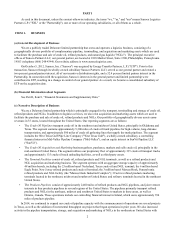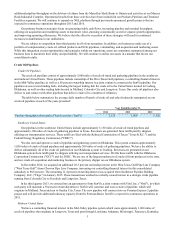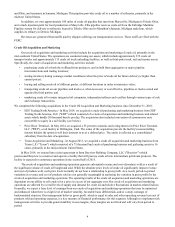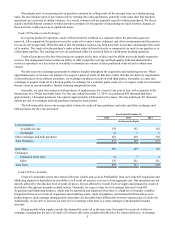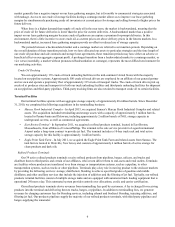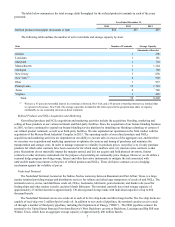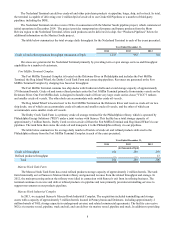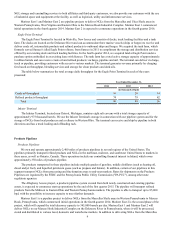Sunoco 2014 Annual Report Download - page 14
Download and view the complete annual report
Please find page 14 of the 2014 Sunoco annual report below. You can navigate through the pages in the report by either clicking on the pages listed below, or by using the keyword search tool below to find specific information within the annual report.12
Competition
Crude Oil Pipelines
Our Crude Oil Pipelines face competition from a number of major oil companies and other smaller entities. Competition
among common carrier pipelines is based primarily on transportation charges, access to crude oil supply, and market demand,
which may be negatively impacted by changes in refiners' supply sources. Additional investment in rail infrastructure to
transport crude oil has also provided increased competition for crude oil pipelines.
Crude Oil Acquisition and Marketing
Our competitors include other crude oil pipeline companies; the major integrated oil companies, their marketing affiliates
and independent gatherers; banks that have established trading platforms; and brokers and marketers of widely varying sizes,
financial resources and experience. Some of these competitors have capital resources many times greater than ours, and control
greater supplies of crude oil. Crude oil acquisition and marketing competitive factors include price and contract flexibility,
quantity and quality of services, and accessibility to end markets.
Terminal Facilities
Our 39 active refined products terminals located in the northeast, midwest and southwest United States compete with
other independent terminals on price, versatility, and services provided. The competition primarily comes from integrated
petroleum companies, refining and marketing companies, independent terminal companies, and distribution companies with
marketing and trading activities. We are not aware of any direct competitors in the butane blending business in the United
States and our patents provide us exclusive use and control over the distribution of our butane blending technology.
Throughput at the Nederland Terminal is primarily related to third-party customers. The primary competitors of the
Nederland Terminal are its refinery customers' docks and other terminal facilities located in the Beaumont, Texas area.
The majority of the throughput at our crude oil terminal facilities in the northeast relates to refining operations at PES's
Philadelphia refinery. In 2012, we entered into a 10-year agreement to provide terminalling services to PES at the Fort Mifflin
Terminal Complex. For further information, see Item 7. "Management's Discussion and Analysis of Financial Condition and
Results of Operations-Agreements with Related Parties."
Products Pipelines
Generally, pipelines are the lowest-cost method for long-haul, overland movement of refined products and NGLs.
Therefore, the most significant competitors for large volume shipments in these areas are other pipelines. Our management
believes that high capital requirements, environmental considerations, and the difficulty in acquiring rights-of-way and related
permits make it difficult for other companies to build competing pipelines in areas served by our pipelines. As a result,
competing pipelines are likely to be built only in those cases in which strong market demand and attractive tariff rates support
additional capacity in an area. Although it is unlikely that a pipeline system comparable in size and scope to the northeast and
midwest portion of the Products Pipelines will be built by our competitors in the foreseeable future, new pipelines (including
pipeline segments that connect with existing pipeline systems) could be built to effectively compete with it in particular
locations.
In the southwest United States, our MagTex refined products pipeline system faces competition from existing third-party
and joint venture pipelines that have excess capacity. Gulf Coast refinery expansions could justify the construction of a new
pipeline that would compete with our products pipeline system in the southwest. However, at this time, we believe the existing
pipelines have the capacity to satisfy expected future demand.
In addition to competition from other pipelines, we face competition from trucks that deliver products in a number of
areas that we serve. While their costs may not be competitive for longer hauls or large volume shipments, trucks compete
effectively for incremental and marginal volume in many areas where such means of transportation are prevalent. The
availability of truck transportation places a significant competitive constraint on our ability to increase tariff rates.


